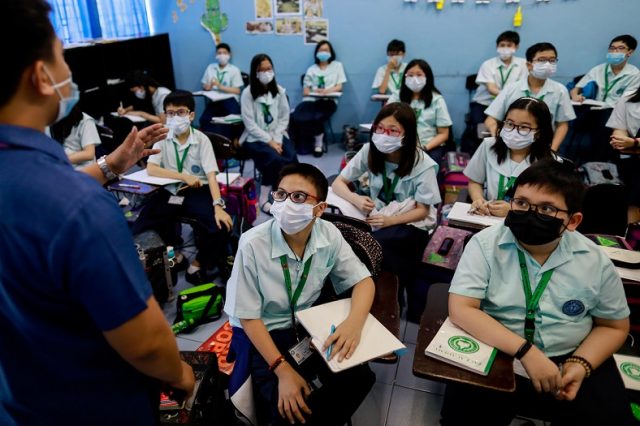
(3rd update, 6:17 p.m.) The Department of Health confirmed the first case of 2019-nCoV in the Philippines. The patient is a 38-year-old woman who arrived in the country on January 21 from Wuhan in China, the ground of the newly discovered strain of coronavirus.
Before the first confirmed case in the Philipines, the number of suspected cases of the new coronavirus strain rose to 27 yesterday, which triggered concerns on the Philippines’ capability to handle another outbreak.
This development came after rumors of suspected cases with the new strain called the 2019-nCoV or Wuhan coronavirus in some parts of Metro Manila caused a social media scare over the weekend.
The health agency posted the announcement on its Facebook account on January 28. It also attached an infographic on the regions of the country where the patients being monitored are located.
These patients are labeled as “persons under investigation.”
Of the 27, the stages of the PUIs are:
RITM pending screening results: 18
VIDRL (Australia) confirmatory results pending: 6
Discharged but under monitoring: 3

Filipinos expressed their fears that the health facilities in the country may not be able to handle the situation should a patient be declared positive of the Wuhan coronavirus.
11 patients from diff region + 3 new patients admitted in San Lazaro Hospital. this is getting scary. pls ban the flights from other infected countries already. i don't wanna sound negative but, admit it our country can't handle this. pic.twitter.com/5nAo6TpUjS
— Mickaela Jazzel Mendoza (@JazzelMickaela) January 27, 2020
Some Filipinos also called for the government to order a travel ban to prevent the epidemic.
“I don’t care if there’s still no confirmed n-COV case. Prevention is better than cure!” one Twitter user said.
11 patients were admitted to San Lazaro Hospital and 3 of them are Chinese nationals from Wuhan. I don't care if there's still no confirmed nCOV case. Prevention is better than cure!!!
Mongolia already banned all flights going to China. PH WHEN WILL YOU?!? 🤦🏻♀️— Hans 🌴 (@itsTadHANNAH) January 27, 2020
Prepared protocols and infrastructure
Health Secretary Francisco Duque assured Malacañang that protocols are in place should nCoV spread here.
“Ang sabi ni Secretary [Francisco] Duque ‘pag nagkaroon ng pagkakataon na manganib na, na mag-spread ‘yan sa ating bansa, ay meron silang gagawing protocols para hindi maging malaganap ang ganoong virus sa atin,” Panelo said.
Health Undersecretary Eric Domingo also previously stated the health agency has “infrastructure” in place if the new disease enters the country.
Government agencies including the Department of the Interior and Local Government, the Department of Foreign Affairs, and the Department of National Defense will take part in this plan.
“It’s just a matter of activating the infrastructure we have ready,” Domingo said.
Last year, Filipinos faced the outbreaks of three vaccine-related diseases, polio (which re-emerged after more than a decade of being polio-free), dengue and measles in 2019.
The measles outbreak in the Philippines last year was one of the world’s worst. San Lazaro Hospital, a facility where infectious and communicable diseases, had to set up tents in the parking lot, hospital yard and even staircase landings.
To contain the outbreak, health agencies and state hospitals led by the DOH launched a massive nationwide vaccination campaign. It is expected that they will do the same preventive measures to mitigate the spread of the novel coronavirus.
The DOH also categorizes some hospitals with a Level 2 and Level 3 license as they are equipped with isolation rooms at the emergency and in-patient departments. Yesterday, January 29, Duque directed all such hospitals to attend to all patients including those suspected to have the new coronavirus.
“Appropriate infection prevention and control measures should be strictly implemented,” Duque wrote in a department circular.
Airports and seaports will also be manned with more personnel led by the Bureau of Quarantine to screen incoming travelers.
Domingo also told reporters that if the World Health Organization declares a public health emergency on the new coronavirus, the Philippines’ health agency will follow procedures similar to that of the MERS outbreak in 2014 and the SARS outbreak in 2003.
CDC: Alert Level 3 for 2019-nCoV
The Center for Disease Control and Prevention in the United States raised the alert level of the Wuhan coronavirus to 3, the highest level, which means precautions against unnecessary travel to China.
“CDC recommends that travelers avoid all nonessential travel to China. In response to an outbreak of respiratory illness, Chinese officials have closed transport within and out of Wuhan and other cities in Hubei province, including buses, subways, trains, and the international airport. Additional restrictions and cancellations of events may occur.”
So far, Mongolia and Hong Kong are the only countries that issued travel restrictions from residents coming from Hubei province, where Wuhan is located, to their territories.
Both Malaysia and the Philippines, meanwhile, stopped the issuing of visas to all travelers from Hubei province.
Immigration Commissioner Jaime Morente said that this temporary restriction is for all Chinese nationals.
“We are taking this proactive measure to slow down travel, and possibly help prevent the entry of the 2019-nCov,” Morente said.
Last January 24, the government deported a total of 135 individuals who landed in Kalibo airport from Wuhan.









